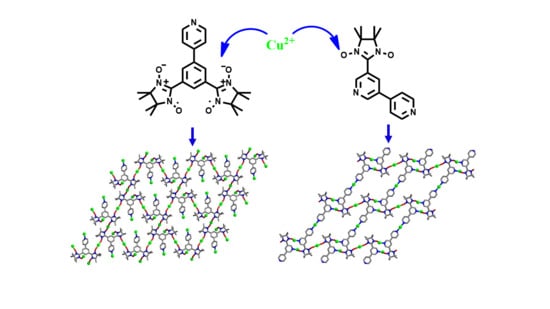Two-Dimensional Nitronyl Nitroxide–Cu Networks Based on Multi-Dentate Nitronyl Nitroxides: Structures and Magnetic Properties
Abstract
:1. Introduction
2. Results and Discussion
2.1. Structural Investigation and Description
2.2. Magnetic Properties
3. Experimental Section
3.1. Raw Materials and Physical Investigation
3.2. Preparation of [Cu7(hfac)14(bisNITPhPy)2]n (1)
3.3. Preparation of [Cu2(hfac)4(NIT-3Py-5-4Py)]n (2)
3.4. Crystallographic Analysis
4. Conclusions
Supplementary Materials
Author Contributions
Funding
Institutional Review Board Statement
Informed Consent Statement
Data Availability Statement
Conflicts of Interest
References
- Vostrikova, K.E. High-spin molecules based on metal complexes of organic free radicals. Coord. Chem. Rev. 2008, 252, 1409–1419. [Google Scholar] [CrossRef]
- Traina, C.; Norel, L.; Baumgarten, M. Organic radicals, a promising route towards original molecule-based magnetic materials. Coord. Chem. Rev. 2009, 253, 2342–2351. [Google Scholar] [CrossRef]
- Fedin, M.V.; Veber, S.L.; Bagryanskaya, E.G.; Ovcharenko, V.I. Electron paramagnetic resonance of switchable copper-nitroxide-based molecular magnets: An indispensable tool for intriguing systems. Coord. Chem. Rev. 2015, 289, 341–356. [Google Scholar] [CrossRef]
- Woodruff, D.N.; Winpeeny, R.E.P.; Layfield, R.A. Lanthanide Single-Molecule Magnets. Chem. Rev. 2013, 113, 5110–5148. [Google Scholar] [CrossRef] [PubMed]
- Demir, S.; Jeon, I.R.; Long, J.R.; Harris, T.D. Radical ligand-containing single-molecule magnets. Coord. Chem. Rev. 2015, 289, 149–176. [Google Scholar] [CrossRef] [Green Version]
- Luneau, D.; Rey, P. Magnetism of metal-nitroxide compounds involving bis-chelating imidazole and benzimidazole substituted nitronyl nitroxide free radicals. Coord. Chem. Rev. 2005, 249, 2591–2611. [Google Scholar] [CrossRef]
- Romero, F.M.; Ziessel, R.; Luneau, D. Structural control of ferromagnetic interactions in nickel(II) complexes based on a tetradentate biradical. Chem. Commun. 1998, 551–552. [Google Scholar] [CrossRef]
- Field, L.M.; Lahti, P.M.; Palacio, F.; Paduan-Filho, A. Manganese(II) and Copper(II) Hexafluoroacetylacetonate 1:1 Complexes with 5-(4-[N-tert-Butyl-N-aminoxyl]phenyl)pyrimidine: Regiochemical Parity Analysis for Exchange Behavior of Complexes between Radicals and Paramagnetic Cations. J. Am. Chem. Soc. 2003, 125, 10110–10118. [Google Scholar] [CrossRef] [PubMed]
- Kanegawa, S.; Karasawa, S.; Nakano, M.; Koga, N. Magnetic behavior of tetrakis [4-(N-tert-butyl-N-oxylamino)pyridine]bis(isocyanato-N)cobalt(II) in frozen solution. Chem. Commun. 2004, 1750–1751. [Google Scholar] [CrossRef] [PubMed]
- Bogani, L.; Sangregorio, C.; Sessoli, R.; Gatteschi, D. Molecular Engineering for Single-Chain-Magnet Behavior in a One-Dimensional Dysprosium-Nitronyl Nitroxide Compound. Angew. Chem. Int. Ed. 2005, 44, 5817–5821. [Google Scholar] [CrossRef] [PubMed]
- Bernot, K.; Bogani, L.; Caneschi, A.; Gatteschi, D.; Sessoli, R. A Family of Rare-Earth-Based Single Chain Magnets: Playing with Anisotropy. J. Am. Chem. Soc. 2006, 128, 7947–7956. [Google Scholar] [CrossRef]
- Demir, S.; Zadrozny, J.M.; Nippe, M.; Long, J.R. Exchange Coupling and Magnetic Blocking in Bipyrimidyl Radical-Bridged Dilanthanide Complexes. J. Am. Chem. Soc. 2012, 134, 18546–18549. [Google Scholar] [CrossRef] [PubMed]
- Poneti, G.; Bernot, K.; Bogani, L.; Caneschi, A.; Sessoli, R.; Wernsdorfer, W.; Gatteschi, D. A rational approach to the modulation of the dynamics of the magnetisation in a dysprosium-nitronyl-nitroxide radical complex. Chem. Commun. 2007, 1807–1809. [Google Scholar] [CrossRef]
- Fatila, E.M.; Rouzieres, M.; Jennings, M.C.; Lough, A.J.; Clérac, R.; Preuss, K.E. Fine-Tuning the Single-Molecule Magnet Properties of a [Dy(III)-Radical]2 Pair. J. Am. Chem. Soc. 2013, 135, 9596–9599. [Google Scholar] [CrossRef] [PubMed]
- Rinehart, J.D.; Fang, M.; Evans, W.J.; Long, J.R. A N23– Radical-Bridged Terbium Complex Exhibiting Magnetic Hysteresis at 14 K. J. Am. Chem. Soc. 2011, 133, 14236–14239. [Google Scholar] [CrossRef]
- Demir, S.; Gonzalez, M.I.; Darago, L.E.; Evans, W.J.; Long, J.R. Giant coercivity and high magnetic blocking temperatures for N23− radical-bridged dilanthanide complexes upon ligand dissociation. Nat. Commun. 2017, 8, 2144. [Google Scholar] [CrossRef] [PubMed] [Green Version]
- Benelli, C.; Gatteschi, D. Magnetism of Lanthanides in Molecular Materials with Transition-Metal Ions and Organic Radicals. Chem. Rev. 2002, 102, 2369–2388. [Google Scholar] [CrossRef] [PubMed]
- Madalan, A.M.; Roesky, H.W.; Andruh, M.; Noltemeyer, M.; Stanica, N. The first coordination compound containing three different types of spin carriers: 2p-3d-4f (TCNQ˙−, Cu2+ and Gd3+). Chem. Commun. 2002, 1638–1639. [Google Scholar] [CrossRef] [PubMed]
- Wang, X.F.; Hu, P.; Li, Y.G.; Li, L.C. Construction of Nitronyl Nitroxide-Based 3d-4f Clusters: Structure and Magnetism. Chem. Asian J. 2015, 10, 325–328. [Google Scholar] [CrossRef]
- Escobar, L.B.L.; Guedes, G.P.; Soriano, S.; Speziali, N.L.; Jordao, A.K.; Cunha, A.C.; Ferreira, V.F.; Maxim, C.; Novak, M.A.; Andruh, M.; et al. New Families of Hetero-tri-spin 2p-3d-4f Complexes: Synthesis, Crystal Structures, and Magnetic Properties. Inorg. Chem. 2014, 53, 7508–7517. [Google Scholar] [CrossRef] [PubMed]
- Wang, Z.X.; Zhang, X.; Zhang, Y.Z.; Li, M.X.; Zhao, H.H.; Andruh, M.; Dunbar, K.R. Single-Chain Magnetic Behavior in a Hetero-Tri-Spin Complex Mediated by Supramolecular Interactions with TCNQF•− Radicals. Angew. Chem. Int. Ed. 2014, 53, 11567–11570. [Google Scholar] [CrossRef]
- Novitchi, G.; Shov, S.; Lan, Y.H.; Wernsdorfer, W.; Train, C. Verdazyl Radical, a Building Block for a Six-Spin-Center 2p-3d-4f Single-Molecule Magnet. Inorg. Chem. 2016, 55, 12122–12125. [Google Scholar] [CrossRef] [PubMed]
- Zhu, M.; Li, L.C.; Sutter, J.P. 2p-3d-4f hetero-tri-spin molecule-based magnetic compounds. Inorg. Chem. Front. 2016, 3, 994–1003. [Google Scholar] [CrossRef]
- Gould, C.A.; Darago, L.E.; Gonzalez, M.I.; Demir, S.; Long, J.R. A Trinuclear Radical-Bridged Lanthanide Single-Molecule Magnet. Angew. Chem. Int. Ed. 2017, 56, 1–6. [Google Scholar] [CrossRef] [PubMed]
- Pointillart, F.; Guennic, B.L.; Golhen, S.; Cador, O.; Ouahab, L. Slow magnetic relaxation in radical cation tetrathiafulvalene-based lanthanide(III) dinuclear complexes. Chem. Commun. 2013, 49, 11632–11634. [Google Scholar] [CrossRef] [PubMed] [Green Version]
- Caneschi, A.; Gatteschi, D.; Lalioti, N.; Sangregorio, C.; Sessoli, R.; Venturi, G.; Vindigni, A.; Rettori, A.; Pini, M.G.; Novak, M.A. Cobalt(II)-Nitronyl Nitroxide Chains as Molecular Magnetic Nanowires. Angew. Chem. Int. Ed. 2001, 40, 1760–1763. [Google Scholar] [CrossRef]
- Liu, X.Q.; Feng, X.W.; Meihaus, K.R.; Meng, X.X.; Zhang, Y.; Li, L.; Liu, J.L.; Shi, W.; Zhang, Y.Q.; Cheng, P.; et al. Coercive Fields Above 6 T in Two Cobalt(II)-Radical Chain Compounds. Angew. Chem. Int. Ed. 2020, 132, 10697–10705. [Google Scholar] [CrossRef]
- Liu, R.N.; Ma, Y.; Yang, P.P.; Song, X.Y.; Xu, G.F.; Tang, J.K.; Li, L.C.; Liao, D.Z.; Yan, S.P. Dynamic magnetic behavior and magnetic ordering in one-dimensional Tb-nitronyl nitroxide radical chain. Dalton Trans. 2010, 39, 3321–3325. [Google Scholar] [CrossRef]
- Liu, R.N.; Li, L.C.; Wang, X.L.; Yang, P.P.; Wang, C.; Liao, D.Z.; Sutter, J.P. Smooth transition between SMM and SCM-type slow relaxing dynamics for a 1-D assemblage of {Dy(nitronyl nitroxide)2} units. Chem. Commun. 2010, 46, 2566–2568. [Google Scholar] [CrossRef]
- Bernot, K.; Pointillart, F.; Rosa, P.; Etienne, M.; Sessoli, R.; Gatteschi, D. Single molecule magnet behaviour in robust dysprosium-biradical complexes. Chem. Commun. 2010, 46, 6458–6460. [Google Scholar] [CrossRef] [Green Version]
- Li, H.D.; Sun, J.; Yang, M.; Sun, Z.; Tang, J.K.; Ma, Y.; Li, L.C. Functionalized Nitronyl Nitroxide Biradicals for the Construction of 3d-4f Heterometallic Compounds. Inorg. Chem. 2018, 57, 9757–9765. [Google Scholar] [CrossRef] [PubMed]
- Xiao, Z.X.; Miao, H.; Shao, D.; Wei, H.Y.; Zhang, Y.Q.; Wang, X.Y. Single-molecule magnet behaviour in a dysprosium-triradical complex. Chem. Commun. 2018, 54, 9726–9729. [Google Scholar] [CrossRef] [PubMed]
- Souza, D.A.; Florencio, A.S.; Soriano, S.; Calvo, R.; Sartoris, R.P.; Carneiro, J.W.M.; Sangregorio, C.; Novak, M.A.; Vaz, M.G.F. New copper(II)-radical one dimensional chain: Synthesis, crystal structure, EPR, magnetic properties and DFT calculations. Dalton Trans. 2009, 6816–6824. [Google Scholar] [CrossRef] [PubMed]
- Wang, X.L.; Li, L.C.; Liao, D.Z. Slow Magnetic Relaxation in Lanthanide Complexes with Chelating Nitronyl Nitroxide Radical. Inorg. Chem. 2010, 49, 4735–4737. [Google Scholar] [CrossRef]
- Lannes, A.; Intissar, M.; Suffren, Y.; Reber, C.; Luneau, D. Terbium(III) and Yttrium(III) Complexes with Pyridine-Substituted Nitronyl Nitroxide Radical and Different β-Diketonate Ligands. Crystal Structures and Magnetic and Luminescence Properties. Inorg. Chem. 2014, 53, 9548–9560. [Google Scholar] [CrossRef]
- Xi, L.; Li, H.D.; Sun, J.; Ma, Y.; Tang, J.K.; Li, L.C. Designing Multicoordinating Nitronyl Nitroxide Radical Toward Multinuclear Lanthanide Aggregates. Inorg. Chem. 2020, 59, 443–451. [Google Scholar] [CrossRef]
- Shi, J.Y.; Wu, M.Z.; Chen, P.Y.; Li, T.; Tian, L.; Zhang, Y.Q. Terbium Triangle Bridged by a Triazole Nitronyl Nitroxide Radical with Single-Molecule-Magnet Behavior. Inorg. Chem. 2019, 58, 14285–14288. [Google Scholar] [CrossRef]
- Tretyakov, E.; Fokin, S.; Romanenko, G.; Ikorskii, V.; Vasilevsky, S.; Ovcharenko, V. 2D and 3D Cu(hfac)2 Complexes with Nitronyl Nitroxide Biradicals. Inorg. Chem. 2006, 45, 3671–3678. [Google Scholar] [CrossRef]
- Zhu, M.; Li, Y.G.; Ma, Y.; Li, L.C.; Liao, D.Z. Unprecedented Nitronyl Nitroxide Bridged 3d-4f Complexes: Structure and Magnetic Properties. Inorg. Chem. 2013, 52, 12326–12328. [Google Scholar] [CrossRef]
- Zhu, M.; Wang, J.; Yang, M.; Ma, Y.; Li, L.C. Slow magnetic relaxation in two-dimensional 3d-4f complexes based on phenyl pyrimidyl substituted nitronyl nitroxide radicals. Dalton Trans. 2015, 44, 9815–9822. [Google Scholar] [CrossRef]
- Sun, G.; Guo, J.; Yang, M.; Xi, L.; Li, L.; Sutter, J.P. Two-dimensional Co-Ln networks bridged by phenyl pyrimidyl substituted nitronyl nitroxides: Structural and magnetic properties. Dalton Trans. 2018, 47, 4672–4677. [Google Scholar] [CrossRef] [PubMed]
- Lanfranc de Panthou, F.; Belorizky, E.; Calemzuk, R.; Luneau, D.; Marcenat, C.; Ressouche, E.; Turek, P.; Rey, P. A New Type of Thermally Induced Spin Transition Associated with an Equatorial.dblarw. Axial Conversion in a Copper(II)-Nitroxide Cluster. J. Am. Chem. Soc. 1995, 117, 11247–11253. [Google Scholar] [CrossRef]
- Wang, H.M.; Liu, Z.L.; Liu, C.M.; Zhang, D.Q.; Lu, Z.L.; Geng, H.; Shuai, Z.G.; Zhu, D.B. Coordination Complexes of 2-(4-Quinolyl) nitronyl Nitroxide with M(hfac)2 [M = Mn(II), Co(II), and Cu(II)]: Syntheses, Crystal Structures, and Magnetic Characterization. Inorg. Chem. 2004, 43, 4091–4098. [Google Scholar] [CrossRef] [PubMed]
- Casanova, D.; Llunell, M.; Alemany, P.; Alvarez, S. The Rich Stereochemistry of Eight-Vertex Polyhedra: A Continuous Shape Measures Study. Chem. Eur. J. 2005, 11, 1479–1494. [Google Scholar] [CrossRef] [PubMed]
- Caneschi, A.; Gatteschi, D.; Sessoli, R.; Hoffmann, S.K. Crystal and molecular structure, magnetic properties and EPR spectra of a trinuclear copper(II) complex with bridging nitronyl nitroxides. Inorg. Chem. 1988, 27, 2390–2392. [Google Scholar] [CrossRef]
- Caneschi, A.; Gatteschi, D.; Sessoli, R.; Rey, P. Toward molecular magnets: The metal-radical approach. Acc. Chem. Res. 1989, 22, 392–398. [Google Scholar] [CrossRef]
- Wang, C.; Wang, Y.L.; Ma, Y.; Wang, Q.L.; Li, L.C.; Liao, D.Z. A Four-spin Cobalt-radical Complex: Structure and Magnetic Properties. Chem. Lett. 2012, 41, 1523–1525. [Google Scholar] [CrossRef]
- Baker, G.; Rushbrooke, G.; Gilbert, H. High-temperature series expansions for the spin-½ Heisenberg model by the method of irreducible representations of the symmetric group. Phys. Rev. 1964, 135, A1272. [Google Scholar] [CrossRef]
- Gatteschi, D.; Laugier, J.; Rey, P.; Zanchini, C. Crystal and molecular structure and magnetic properties of the adducts of copper(II) hexafluoroacetylacetonate with the nitroxide ligand 2-phenyl-4,4,5,5-tetramethylimidazoline-1-oxyl-3-oxide. Inorg. Chem. 1987, 26, 938–943. [Google Scholar] [CrossRef]
- Cabello, C.I.; Caneschi, A.; Carlin, R.L.; Gatteschi, D.; Rey, P.; Sessoli, R. Structure and magnetic properties of ferromagnetic alternating spin chains. Inorg. Chem. 1990, 29, 2582–2587. [Google Scholar] [CrossRef]
- Caneschi, A.; Gatteschi, D.; Laugier, J.; Rey, P. Ferromagnetic alternating spin chains. J. Am. Chem. Soc. 1987, 109, 2191–2192. [Google Scholar] [CrossRef]
- Wang, X.F.; Hu, P.; Li, L.C.; Sutter, J.P. [(Cu-Radical)2-Ln]: Structure and Magnetic Properties of a Hetero-trispin Chain of Rings (Ln = YIII, GdIII, TbIII, DyIII). Inorg. Chem. 2015, 54, 9664–9669. [Google Scholar] [CrossRef] [PubMed]
- Lu, J.; Jing, P.; Jin, C.Y.; Xie, J.F.; Li, L.C. Modulating the magnetization dynamics in Ln–Cu-Rad hetero-tri-spin complexes through cis/trans coordination of nitronyl nitroxide radicals around the metal center. Dalton Trans. 2021, 50, 3280–3288. [Google Scholar] [CrossRef] [PubMed]
- Sheldrick, G.M. SHELXS-2014, Program. for Structure Solution; Universität of Göttingen: Gottingen, Germany, 2014. [Google Scholar]
- Sheldrick, G.M. SHELXL-2014, Program. for the Refinement of Crystal Structures; Universität of Göttingen: Göttingen, Germany, 2014. [Google Scholar]
- Spek, A.L. Structure validation in chemical crystallography. Acta Crystallogr. 2009, D65, 148–155. [Google Scholar] [CrossRef] [PubMed]
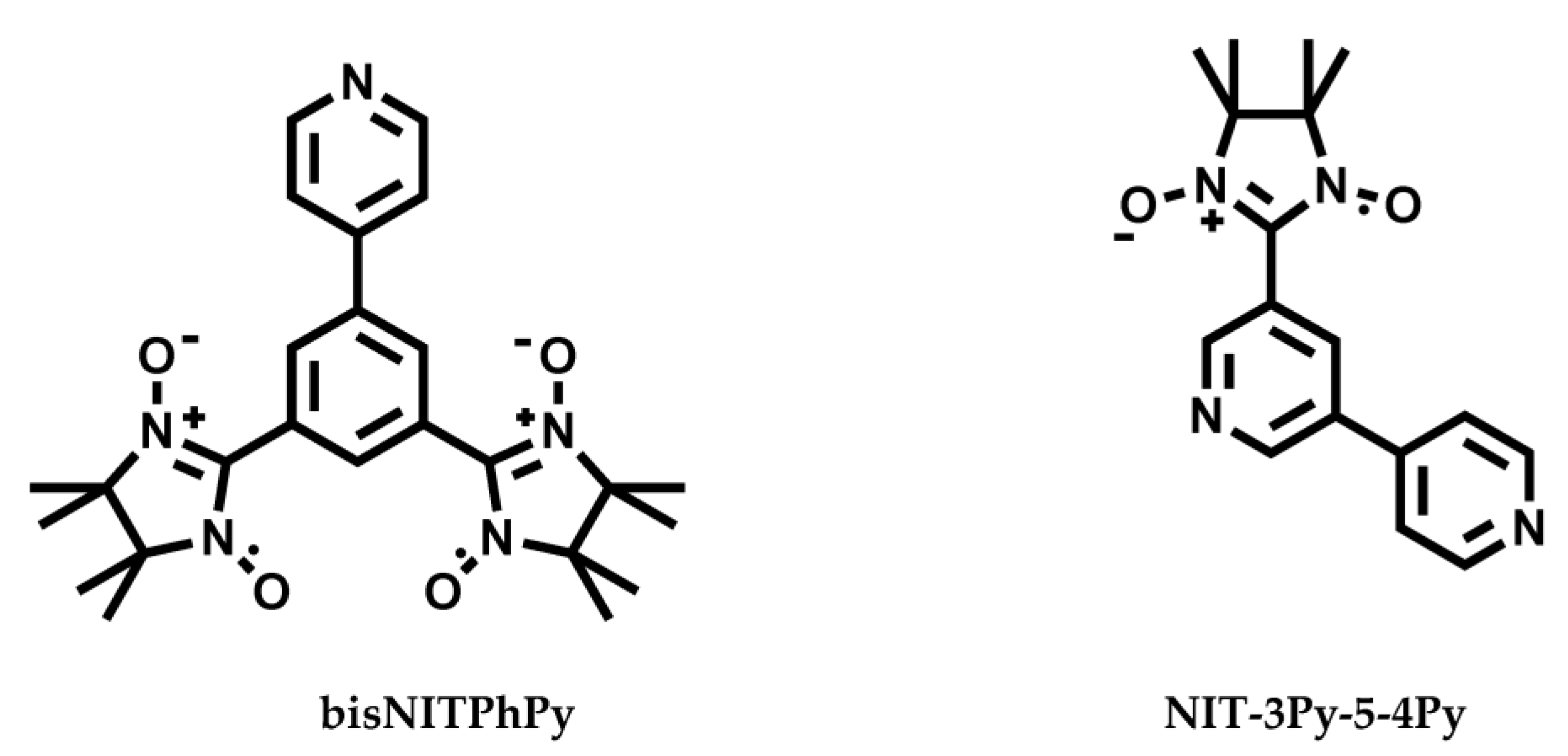
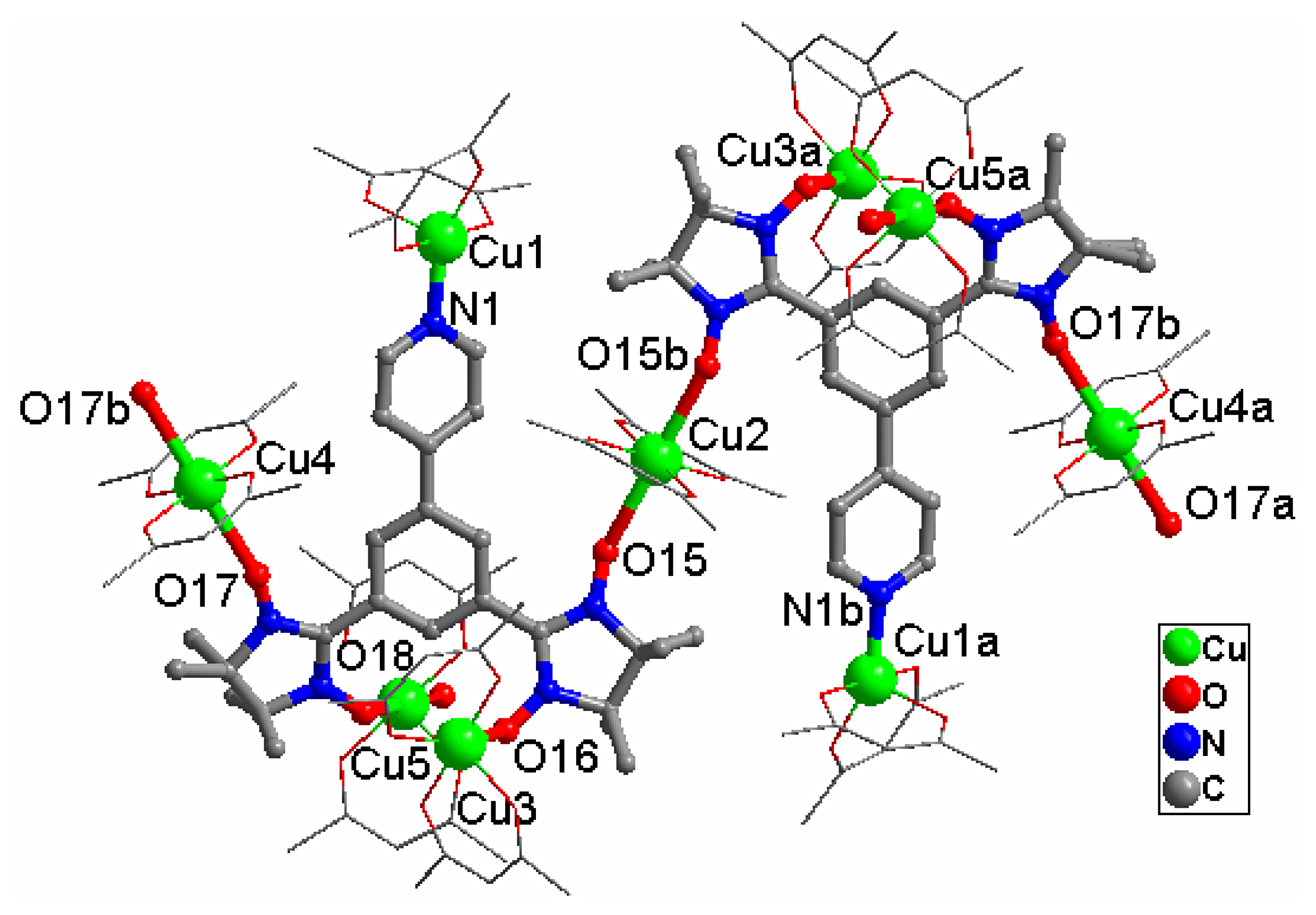

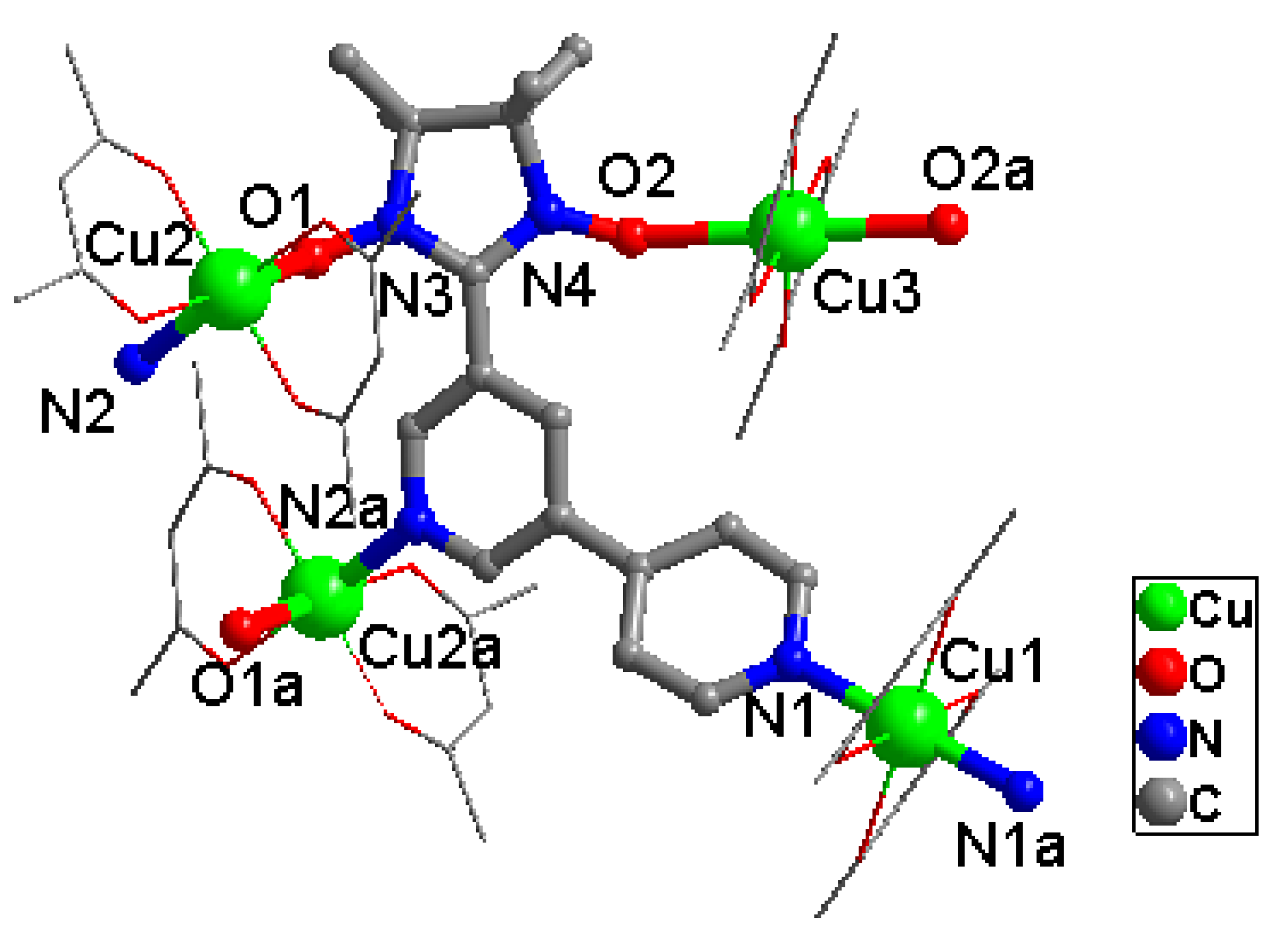
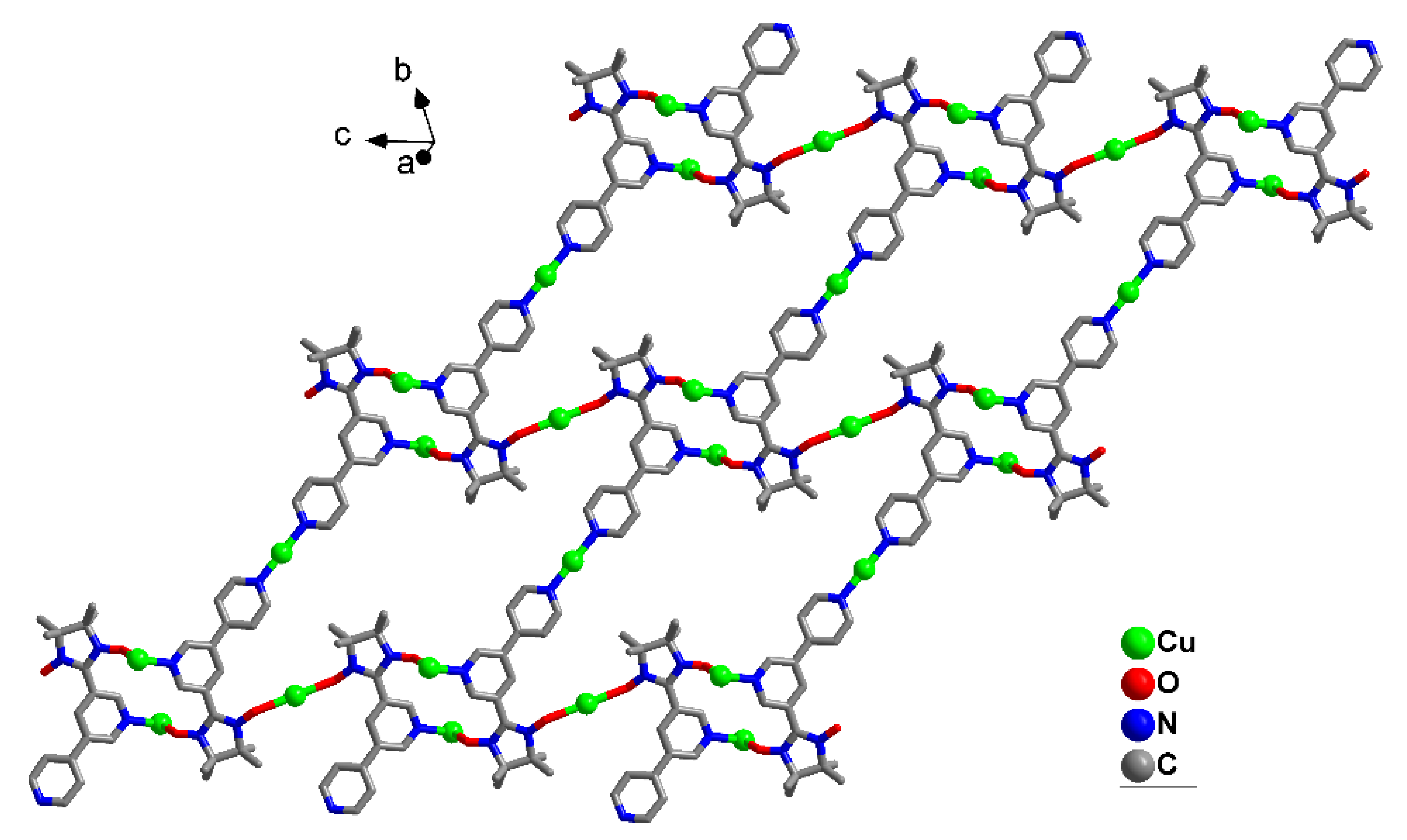
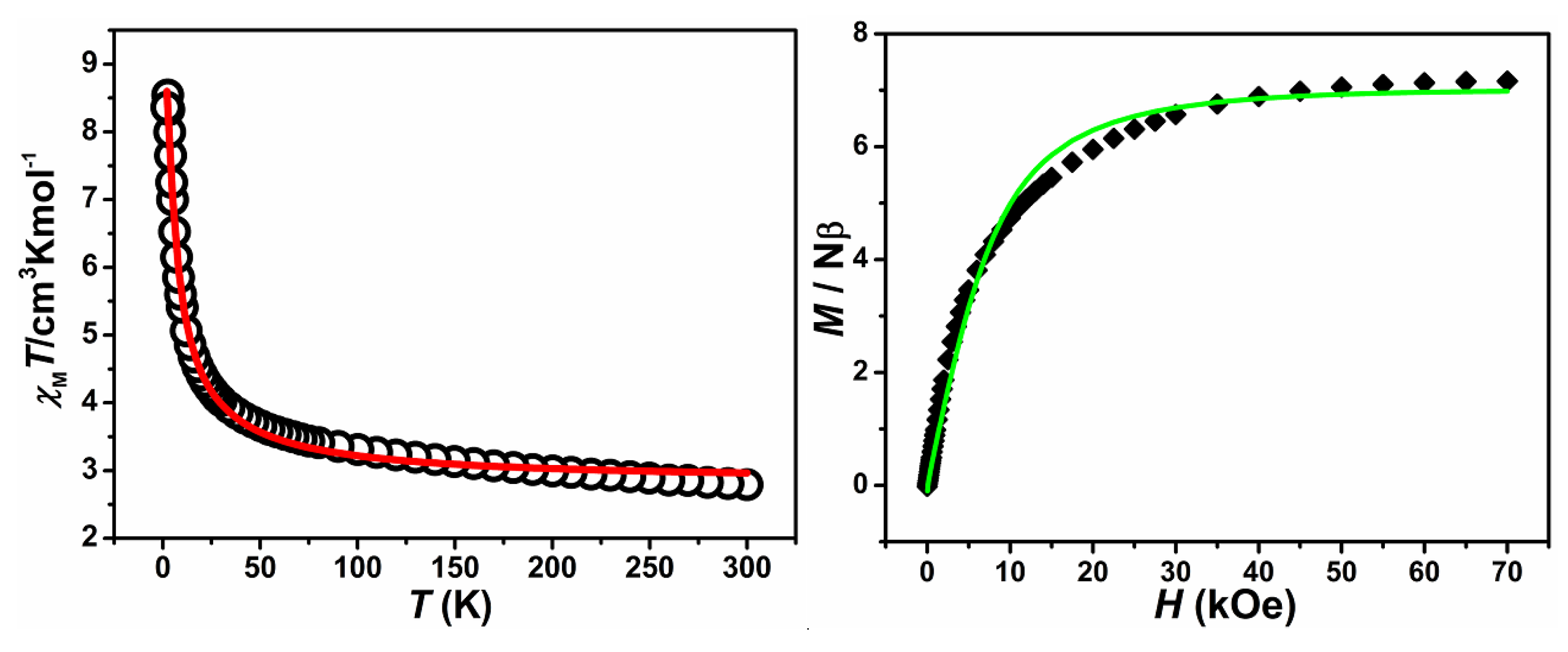
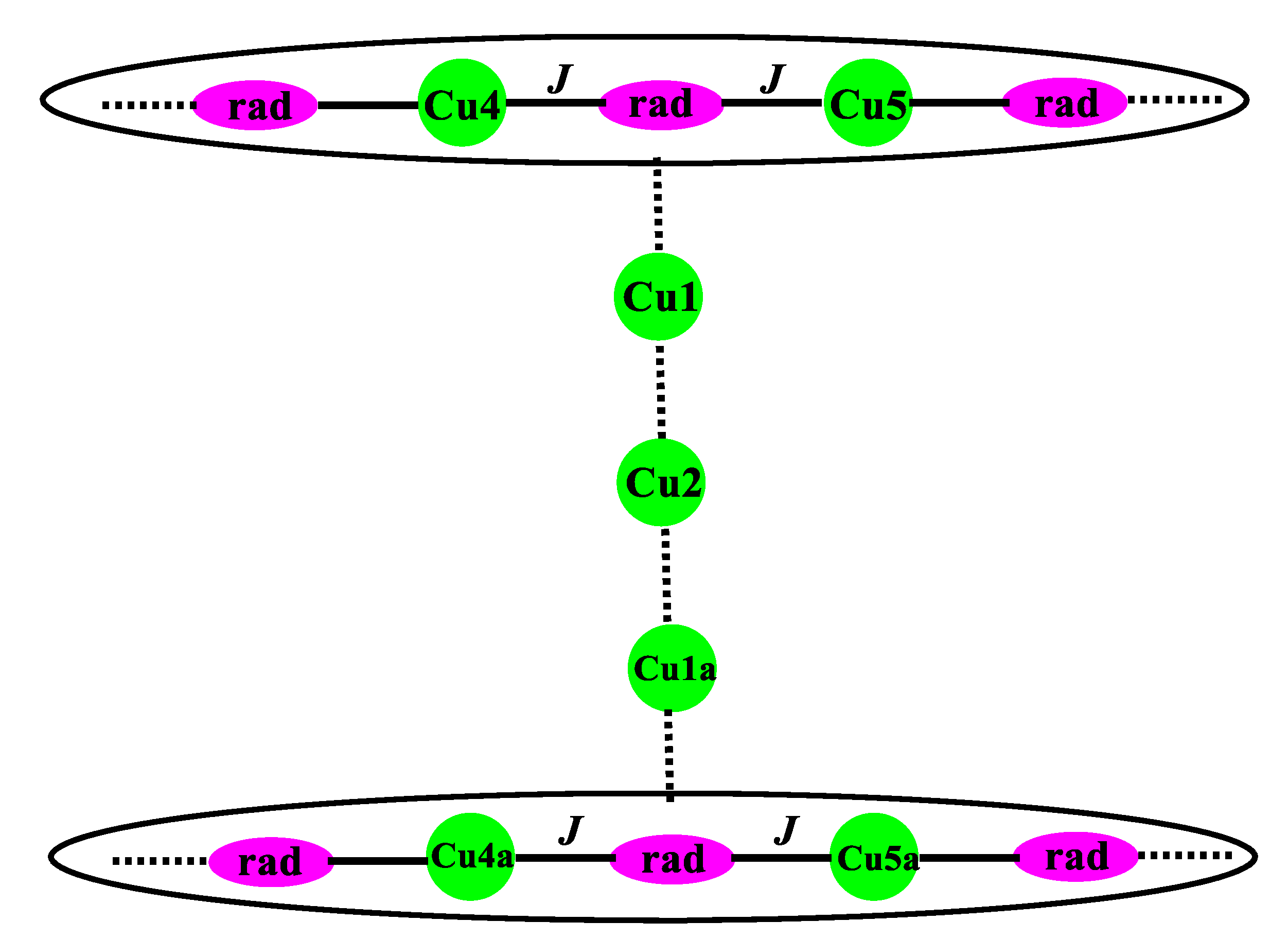
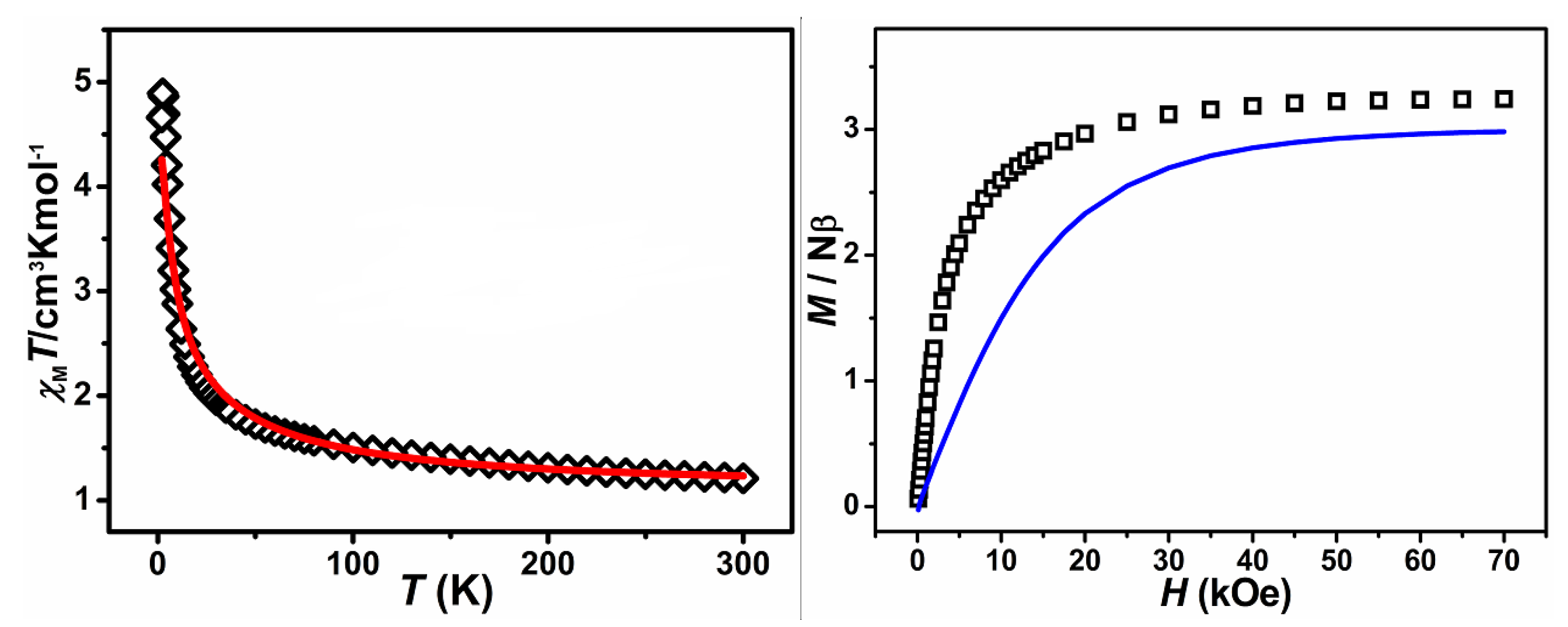

| Complex | 1 | 2 |
|---|---|---|
| Formula | C120H76Cu7F84N10O36 | C53H38F36Tb2N6O17 |
| M (g·mol−1) | 4274.76 | 1266.67 |
| T (K) | 113(2) | 113(2) |
| Crystal system | Triclinic | Triclinic |
| Space group | Pī | Pī |
| a (Å) | 13.4647(13) | 11.172(2) |
| b (Å) | 16.7473(18) | 15.205(3) |
| c (Å) | 18.793(2) | 15.890(3) |
| α (°) | 109.221(2) | 78.94(3) |
| β (°) | 96.022(2) | 85.98(3) |
| γ (°) | 98.901(2) | 70.21(3) |
| Z | 1 | 2 |
| Dcalcd (g·cm–3) | 1.821 | 1.688 |
| μ (mm–1) | 1.113 | 0.998 |
| θ (°) | 3.00–25.00 | 1.93–25.00 |
| F(000) | 2113 | 1254 |
| Reflns collected | 36,087 | 24,124 |
| Unique reflns/Rint | 13,715/0.0429 | 8784/0.0598 |
| GOF (F2) | 0.983 | 1.007 |
| R1/wR2 (I > 2σ(I)) | 0.0497, 0.1412 | 0.0927, 0.2159 |
| R1/wR2 (all data) | 0.0663, 0.1511 | 0.1149, 0.2363 |
Publisher’s Note: MDPI stays neutral with regard to jurisdictional claims in published maps and institutional affiliations. |
© 2021 by the authors. Licensee MDPI, Basel, Switzerland. This article is an open access article distributed under the terms and conditions of the Creative Commons Attribution (CC BY) license (https://creativecommons.org/licenses/by/4.0/).
Share and Cite
Li, H.; Lu, J.; Xie, J.; Jing, P.; Li, L. Two-Dimensional Nitronyl Nitroxide–Cu Networks Based on Multi-Dentate Nitronyl Nitroxides: Structures and Magnetic Properties. Magnetochemistry 2021, 7, 73. https://doi.org/10.3390/magnetochemistry7050073
Li H, Lu J, Xie J, Jing P, Li L. Two-Dimensional Nitronyl Nitroxide–Cu Networks Based on Multi-Dentate Nitronyl Nitroxides: Structures and Magnetic Properties. Magnetochemistry. 2021; 7(5):73. https://doi.org/10.3390/magnetochemistry7050073
Chicago/Turabian StyleLi, Hongdao, Jiao Lu, Jing Xie, Pei Jing, and Licun Li. 2021. "Two-Dimensional Nitronyl Nitroxide–Cu Networks Based on Multi-Dentate Nitronyl Nitroxides: Structures and Magnetic Properties" Magnetochemistry 7, no. 5: 73. https://doi.org/10.3390/magnetochemistry7050073





